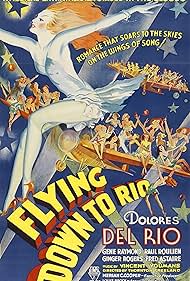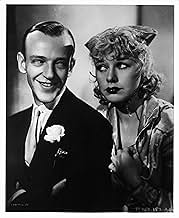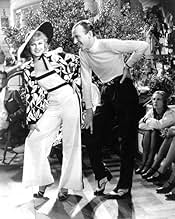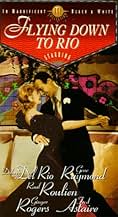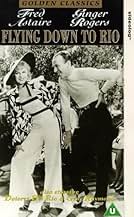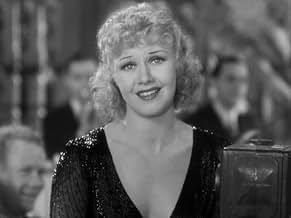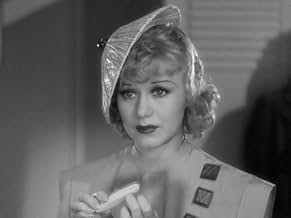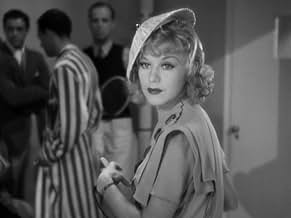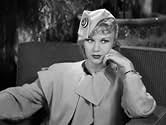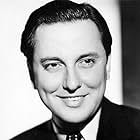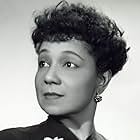IMDb RATING
6.6/10
4.2K
YOUR RATING
A bandleader woos a Latin flame who is already engaged to his employer.A bandleader woos a Latin flame who is already engaged to his employer.A bandleader woos a Latin flame who is already engaged to his employer.
- Nominated for 1 Oscar
- 1 win & 2 nominations total
Dolores Del Río
- Belinha De Rezende
- (as Dolores Del Rio)
Luis Alberni
- Rio Casino Manager
- (uncredited)
Bernice Alstock
- Singer
- (uncredited)
Chita Andrews
- Check Girl
- (uncredited)
Featured reviews
Consider this. RKO released "Flying down to Rio" in 1933, when America was in the very depths of the Great Depression. Millions of Americans were out of work and millions more lived in fear of the economic and political realities plaguing the world.
So Hollywood turned out films like this one, escapist fare about rich dilettantes drifting back and forth from Miami to Rio. Indeed, the hero of this little trifle, Gene Raymond, is the scion of a wealthy family who will inherit lots of money, if he gives up fiddling around with song writing and aviation. And the thing is, pictures liked this one worked. The unemployed probably didn't have the ten cents or more it took to get in to see gems like this, but those who did have the money turned out for this kind of picture, gawking at the upper classes in wonder.
"Flying down to Rio," though, is an early talkie and hardly the best example of this kind of romantic comedy. Directed by Thornton Freeland, an early talkie director whose career was largely undistinguished, it has a loose feel about it and does not marry sound and visuals together with any real skill. The pacing is bad, the musical numbers drag on way too long and the film is not the kind of polished production RKO and the rest of Hollywood would start turning out within the next few years.
But "Flying Down to Rio" is remembered today for one thing and one thing only, the first pairing of Fred Astaire and Ginger Rogers, who would become the greatest dance team in movie history. That pairing almost didn't happen, because Ginger's role was originally earmarked for starlet Dorothy Jordan, who wound up catching the eye of Merian C. Cooper, then riding high at RKO after the spectacular success of "King Kong." Jordan became Cooper's girlfriend and quickly his wife and Ginger stepped into her dance shoes and from there into screen immortality. Ironically, Fred and Ginger are not the leads in this film and actually only do one dance number together, but they were good enough to convince the powers that be that new stars had been born, providing those stars could dance their way through their future films.
But aside from that number, there are a couple of other reasons to see this film. The first is top billed star Dolores Del Rio, one of the most beautiful women to ever turn up on the screen. A wealthy socialite from Mexico, she arrived in Hollywood in the silent era and became famous playing a French peasant girl being romanced by two American soldiers in "What Price Glory." Her transition to sound was rocky, though, not because of her voice, but rather what felled many a silent star, her "foreign accent." But it didn't kill her. She returned to Mexico and helped launch its film industry.
Aside from Del Rio, the other things to look for are the Depression era sets. Built to depict hotels and elaborate supper clubs, they are among the most spectacular of the era. And then, finally, there is that other sequence this film is known for, the truly amazing production number featuring the title song, "Flying Down to Rio" in which a bevy of beautiful girls allow themselves to be strapped to the wings of biplanes and flown over Rio as entertainment during the opening of a hotel. While the overwhelming majority of the footage are probably process shots, there appear to be a couple of real life wing walker type shots blended in to give the sequence a realistic feel.
Merian Cooper, then RKO's defacto production boss, was among many other things a pilot himself, an aviation buff and one of the founders of Pan American Airways, the airline that pioneered trans-ocean flight. And even before the famed Pan Am Clippers crossed the Atlantic and the Pacific in the mid-thirties, they'd already established mail and early passenger service to South America with the Sikorsky S-40 nd S-42 flying boats,shown at the end of the film.
In some ways, this film is one big advertisement for the Clippers and for aviation, back when it looked like fun. But then, the real fun was watching Astaire and Rogers in subsequent films proving that in addition to having a good eye for manly stuff like big gorillas and airplanes, Merian C.Cooper was not exactly blind to musical talent, either.
So Hollywood turned out films like this one, escapist fare about rich dilettantes drifting back and forth from Miami to Rio. Indeed, the hero of this little trifle, Gene Raymond, is the scion of a wealthy family who will inherit lots of money, if he gives up fiddling around with song writing and aviation. And the thing is, pictures liked this one worked. The unemployed probably didn't have the ten cents or more it took to get in to see gems like this, but those who did have the money turned out for this kind of picture, gawking at the upper classes in wonder.
"Flying down to Rio," though, is an early talkie and hardly the best example of this kind of romantic comedy. Directed by Thornton Freeland, an early talkie director whose career was largely undistinguished, it has a loose feel about it and does not marry sound and visuals together with any real skill. The pacing is bad, the musical numbers drag on way too long and the film is not the kind of polished production RKO and the rest of Hollywood would start turning out within the next few years.
But "Flying Down to Rio" is remembered today for one thing and one thing only, the first pairing of Fred Astaire and Ginger Rogers, who would become the greatest dance team in movie history. That pairing almost didn't happen, because Ginger's role was originally earmarked for starlet Dorothy Jordan, who wound up catching the eye of Merian C. Cooper, then riding high at RKO after the spectacular success of "King Kong." Jordan became Cooper's girlfriend and quickly his wife and Ginger stepped into her dance shoes and from there into screen immortality. Ironically, Fred and Ginger are not the leads in this film and actually only do one dance number together, but they were good enough to convince the powers that be that new stars had been born, providing those stars could dance their way through their future films.
But aside from that number, there are a couple of other reasons to see this film. The first is top billed star Dolores Del Rio, one of the most beautiful women to ever turn up on the screen. A wealthy socialite from Mexico, she arrived in Hollywood in the silent era and became famous playing a French peasant girl being romanced by two American soldiers in "What Price Glory." Her transition to sound was rocky, though, not because of her voice, but rather what felled many a silent star, her "foreign accent." But it didn't kill her. She returned to Mexico and helped launch its film industry.
Aside from Del Rio, the other things to look for are the Depression era sets. Built to depict hotels and elaborate supper clubs, they are among the most spectacular of the era. And then, finally, there is that other sequence this film is known for, the truly amazing production number featuring the title song, "Flying Down to Rio" in which a bevy of beautiful girls allow themselves to be strapped to the wings of biplanes and flown over Rio as entertainment during the opening of a hotel. While the overwhelming majority of the footage are probably process shots, there appear to be a couple of real life wing walker type shots blended in to give the sequence a realistic feel.
Merian Cooper, then RKO's defacto production boss, was among many other things a pilot himself, an aviation buff and one of the founders of Pan American Airways, the airline that pioneered trans-ocean flight. And even before the famed Pan Am Clippers crossed the Atlantic and the Pacific in the mid-thirties, they'd already established mail and early passenger service to South America with the Sikorsky S-40 nd S-42 flying boats,shown at the end of the film.
In some ways, this film is one big advertisement for the Clippers and for aviation, back when it looked like fun. But then, the real fun was watching Astaire and Rogers in subsequent films proving that in addition to having a good eye for manly stuff like big gorillas and airplanes, Merian C.Cooper was not exactly blind to musical talent, either.
There was a golden age of cinema lasting only four or five years - from the end of the silent era to the beginning of the Hays Code, the severe censorship rules which sought to turn cinema from naughty to nice, but in actuality sapped them of their truth and energy.
`Flying Down to Rio' is a classic pre-Hayes code talkie, and its characters have a quality of frankness which endears them to modern audience far more than many later films, whose stilted, conservative quality is somewhat alienating. You'd be surprised at what they could get away with in those days - it would be forty years before a film could get away with a line like that spoken by a starlet of her South American rivals - `What have those girls got below the equator that we haven't got?'
The film, about a love triangle between a Brazilian woman and two members of a swing band, is of course famous for two things - the slightly surreal sequence in which showgirls ride a biplane down to Rio in Busby Berkley-esque formation, and the debut of Fred Astaire and Ginger Rogers as a screen team. It's no wonder that audiences fell in love with the duo, whose `Carioca' is the highlight of the film.
They only made them like this for a little while - more's the shame!
`Flying Down to Rio' is a classic pre-Hayes code talkie, and its characters have a quality of frankness which endears them to modern audience far more than many later films, whose stilted, conservative quality is somewhat alienating. You'd be surprised at what they could get away with in those days - it would be forty years before a film could get away with a line like that spoken by a starlet of her South American rivals - `What have those girls got below the equator that we haven't got?'
The film, about a love triangle between a Brazilian woman and two members of a swing band, is of course famous for two things - the slightly surreal sequence in which showgirls ride a biplane down to Rio in Busby Berkley-esque formation, and the debut of Fred Astaire and Ginger Rogers as a screen team. It's no wonder that audiences fell in love with the duo, whose `Carioca' is the highlight of the film.
They only made them like this for a little while - more's the shame!
I gave this "Fred Astaire" comedy-romance-musical higher marks than normal because the romance, usually the sappy part of the Astaire films, doesn't dominate as it does most of his movies.
As usual, there are a number of interesting dance scenes including a spectacular Busby Berkeley-type production on the wings of airplanes. That scene has to be seen to be believed, not just for the uniqueness of it but for the bra-less women pictured! Yikes, it's not something you expect to see with a classic film - and you wouldn't see for another 35 years. It's pretty amazing.
I really shouldn't label this an "Astaire film " because Dolores Del Rio and Gene Raymond are the two stars. Astaire is a close third. Raul Roulien would be next while Ginger Rogers just has a small role.....but it IS noteworthy for being the first time all of us saw the famous Astaire-Rogers pairing.
The comedy in this film also is pretty good. The best parts of the film are the beginning and end. The fadeout segways in here reminded of silent films, which weren't that long removed from this.
As usual, there are a number of interesting dance scenes including a spectacular Busby Berkeley-type production on the wings of airplanes. That scene has to be seen to be believed, not just for the uniqueness of it but for the bra-less women pictured! Yikes, it's not something you expect to see with a classic film - and you wouldn't see for another 35 years. It's pretty amazing.
I really shouldn't label this an "Astaire film " because Dolores Del Rio and Gene Raymond are the two stars. Astaire is a close third. Raul Roulien would be next while Ginger Rogers just has a small role.....but it IS noteworthy for being the first time all of us saw the famous Astaire-Rogers pairing.
The comedy in this film also is pretty good. The best parts of the film are the beginning and end. The fadeout segways in here reminded of silent films, which weren't that long removed from this.
Howard Hughes, oh how we needed you.
From other sources you will have learned that this is pretty sexy stuff in terms of transparent clothes; not a bra on the hundreds of candidates. And the original dirty dancing before it was outlawed, and that crack about what Brazilian women have "below the equator." Also, you will have heard about this being the first Astaire-Rogers pairing.
You may not have heard of one of the most racially respectful scenes I know from the era: a couple land on a supposedly deserted island and the woman is frightened by what she thinks are natives. Turns out one comes out of the woods. He's playing golf and while shirtless (in order to make the joke work) speaks English normally and carries himself like a regular man. Its the reverse joke of what you'd usually see in bugeyed stepinfetchits.
But what I find fascinating is the way sex, romance, money and music are all somehow related to aviation. Our hero, we are told is heir to a fortune if only he would give up his music and planes. But it is plain that he does it because of the women. And by that we know he means sex, only sex. We first see him as he climbs out of his plane, which has a piano stuffed in it. Now think about that a minute.
This is what technology meant in those days: adventure, charm, bodily pleasure. And its what the sort of music we see in films was supposed to imply as well. If you do not see this, let me describe the climax. Scores of scantily clad women are strapped to what looks like a dozen small planes to perform choreographically as best you can when bolted down. Every shot you can take of a woman's body is presented, along with a wingload of errant nipples. I can just imagine the smiles when they thought it up.
There's something else to watch for. This has the most elaborate transitions I believe I have seen for any film. They really are amazingly varied and so copious they are as much a feature as Fred's dancing.
Ted's Evaluation -- 2 of 3: Has some interesting elements.
From other sources you will have learned that this is pretty sexy stuff in terms of transparent clothes; not a bra on the hundreds of candidates. And the original dirty dancing before it was outlawed, and that crack about what Brazilian women have "below the equator." Also, you will have heard about this being the first Astaire-Rogers pairing.
You may not have heard of one of the most racially respectful scenes I know from the era: a couple land on a supposedly deserted island and the woman is frightened by what she thinks are natives. Turns out one comes out of the woods. He's playing golf and while shirtless (in order to make the joke work) speaks English normally and carries himself like a regular man. Its the reverse joke of what you'd usually see in bugeyed stepinfetchits.
But what I find fascinating is the way sex, romance, money and music are all somehow related to aviation. Our hero, we are told is heir to a fortune if only he would give up his music and planes. But it is plain that he does it because of the women. And by that we know he means sex, only sex. We first see him as he climbs out of his plane, which has a piano stuffed in it. Now think about that a minute.
This is what technology meant in those days: adventure, charm, bodily pleasure. And its what the sort of music we see in films was supposed to imply as well. If you do not see this, let me describe the climax. Scores of scantily clad women are strapped to what looks like a dozen small planes to perform choreographically as best you can when bolted down. Every shot you can take of a woman's body is presented, along with a wingload of errant nipples. I can just imagine the smiles when they thought it up.
There's something else to watch for. This has the most elaborate transitions I believe I have seen for any film. They really are amazingly varied and so copious they are as much a feature as Fred's dancing.
Ted's Evaluation -- 2 of 3: Has some interesting elements.
In Miami, during the presentation of the Yankee Clippers, the wolf band leader and pilot Roger Bond (Gene Raymond) flirts with the guest Belinha de Resende (Dolores Del Rio) and the stringent hotel manager fires them. However, the band is hired for the opening night of the Atlântico Hotel in Rio de Janeiro, and they need to fly to Brazil.
When Roger meets Belinha in the hall of the hotel, he learns that she lost her flight to Rio and he offers a ride for her in his plane. Roger is forced to land in an island and he immediately fixes the mechanical problem in the plane; however, he lies to Belinha and tells that he can not fix the problem just to spend the night alone with her. But Belinha, who is the fiancée of the Brazilian Júlio, resists to his harassment and later she finds another plane to fly to Rio.
Once in Rio, the infatuated Roger meets his friend Júlio without knowing that he is the fiancé of Belinha, and he tells about his love for the woman. When the Yankee Clippers are ready to open the hotel, powerful bankers that are interested to force the bankruptcy of the Atlântico's owner to take the hotel, send the police since he does not have the permit to anticipate the opening day. However, Roger's friend and musician Fred Ayres (Fred Astaire) proposes an airborne show to the guests. Meanwhile, the brokenhearted Roger decides to return to his country and leave Belinha with Júlio.
"Flying Down to Rio" is the debut of the pair Fred and Ginger in minor support roles. The sappy and naive romance has the Mexican Dolores Del Rio performing a Brazilian sassy woman and Gene Raymond in the lead roles. The footages from Rio de Janeiro in the 30's and the airborne show are the best moments of this film. The funniest thing in "Flying Down to Rio" is that there is no Brazilian actor or actress in the cast. My vote is six.
Title (Brazil): "Voando para o Rio" ("Flying to Rio")
When Roger meets Belinha in the hall of the hotel, he learns that she lost her flight to Rio and he offers a ride for her in his plane. Roger is forced to land in an island and he immediately fixes the mechanical problem in the plane; however, he lies to Belinha and tells that he can not fix the problem just to spend the night alone with her. But Belinha, who is the fiancée of the Brazilian Júlio, resists to his harassment and later she finds another plane to fly to Rio.
Once in Rio, the infatuated Roger meets his friend Júlio without knowing that he is the fiancé of Belinha, and he tells about his love for the woman. When the Yankee Clippers are ready to open the hotel, powerful bankers that are interested to force the bankruptcy of the Atlântico's owner to take the hotel, send the police since he does not have the permit to anticipate the opening day. However, Roger's friend and musician Fred Ayres (Fred Astaire) proposes an airborne show to the guests. Meanwhile, the brokenhearted Roger decides to return to his country and leave Belinha with Júlio.
"Flying Down to Rio" is the debut of the pair Fred and Ginger in minor support roles. The sappy and naive romance has the Mexican Dolores Del Rio performing a Brazilian sassy woman and Gene Raymond in the lead roles. The footages from Rio de Janeiro in the 30's and the airborne show are the best moments of this film. The funniest thing in "Flying Down to Rio" is that there is no Brazilian actor or actress in the cast. My vote is six.
Title (Brazil): "Voando para o Rio" ("Flying to Rio")
Storyline
Did you know
- TriviaStanding outside a bakery shop in Rio, Ginger Rogers asks, "Oh, Freddie, how do you ask for little tarts in Portuguese?" Fred Astaire replies, "Don't heckle me, try the Culbertson System." This pre-Code, double entendre joke would have been funny to Depression-era audiences, for whom bridge was a common pastime. Ely Culbertson was a champion bridge player and worldwide celebrity, who had won several international tournaments by developing a rather aggressive bidding system. He was also notorious for his sexual exploits. His 1940 autobiography was banned in many countries. In the 1930s, the word "tart" was equivalent to "slut" or "whore". Also, in the opening inspection of hotel staff, the boss sees a maid whose shoe heels are oddly beveled and says he will not tolerate that sort of thing. A "round-heeled woman" was 1930s slang for a prostitute, a woman who could tilt easily from standing to being on her back.
- GoofsFrom the height they were flying, most of the "dance" routines of the young women on the plane wings would not be visible to people on the ground.
While true, this observation is not a Goof. The purpose of the event likely was more for advertising or Newsreel value, or even simply "bragging rights".
- Quotes
Belinha's Friend: What have these South Americans got below the equator that we haven't?
- ConnectionsFeatured in Hollywood and the Stars: The Fabulous Musicals (1963)
- SoundtracksMusic Makes Me
(1933) (uncredited)
Music by Vincent Youmans
Lyrics by Gus Kahn and Edward Eliscu
Performed by Ginger Rogers
- How long is Flying Down to Rio?Powered by Alexa
Details
Box office
- Budget
- $462,000 (estimated)
- Runtime1 hour 29 minutes
- Color
- Aspect ratio
- 1.37 : 1
Contribute to this page
Suggest an edit or add missing content

